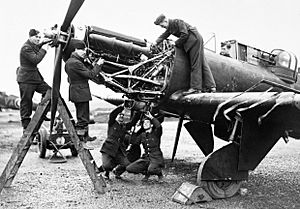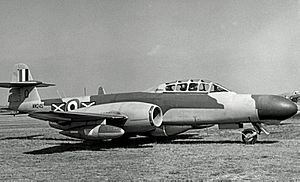No. 125 Squadron RAF facts for kids
Quick facts for kids No. 125 (Newfoundland) Squadron RAF |
|
|---|---|
| Active | 1 February 1918 – 1 April 1918 (RFC) 1 April 1918 – 1 August 1918 (RAF) 16 June 1941 – 20 November 1945 31 March 1955 – 10 May 1957 |
| Country | |
| Branch | |
| Role | Fighter Command / Night Fighter |
| Nickname(s) | Newfoundland |
| Motto(s) | Latin: Nunquam domandi ("Never to be tamed") |
| Battle honours | • World War II • Home Defence • Operation Overlord |
| Insignia | |
| Squadron Badge heraldry | On a mount, a caribou. Approved by King George VI in April 1944. (The caribou is the official animal of Newfoundland) |
| Squadron roundel |  |
| Squadron Codes | FN (Apr 1939 – Sep 1939) VA (Jun 1941 – Nov 1945) |
No. 125 (Newfoundland) Squadron was a special unit of the Royal Air Force (RAF). It was active during World War II and for a short time in the mid-1950s. This squadron was mainly known for flying night fighters, which are planes designed to fight enemy aircraft at night.
Contents
History of No. 125 Squadron
Early Days in World War I
No. 125 Squadron first started on February 1, 1918. This was during the First World War. It was formed at Old Sarum Airfield in England. The squadron was part of the Royal Flying Corps, which was the air force before the RAF.
Their job was to be a light bomber squadron. They flew planes like the Airco DH.4 and Airco DH.9. The plan was for them to go to France in September. However, the squadron was closed down on August 1, 1918. This means they never actually fought in the First World War.
Fighting in World War II
No. 125 Squadron was started again on June 16, 1941. This time, it was at RAF Colerne and they flew Bolton-Paul Defiant night fighters. The squadron was created thanks to money from the Newfoundland Commission of Government. In 1940, they gave the British Government $500,000. They hoped this money would help create a squadron with pilots from Newfoundland.
Their wish came true! Many Newfoundlanders flew with No. 125 Squadron. There were also pilots from England, Scotland, Wales, other Commonwealth countries, and Poland.
Becoming Fully Operational
On September 24, 1941, the squadron moved to RAF Fairwood Common in Wales. Here, they became fully ready for combat. The Defiant planes were very good at fighting at night. By February 1942, the squadron started using new planes. They switched to the two-engine Bristol Beaufighter. These planes were ready for action by April 21. They also used Defiants and Hawker Hurricanes to help with patrols.
Many Newfoundlanders were in No. 125 Squadron. Some pilots even named their planes after places in Newfoundland. Names like St. John's, Corner Brook, Deer Lake, and Buchans were used. From October to December 1942, a small group from the squadron worked from RAF Sumburgh in the Shetland Islands.
Moving Around and New Planes
On November 14, 1943, No. 125 Squadron moved north to RAF Valley. Their job was to patrol the skies over the Irish Sea. While there, a small group also worked from RAF Ballyhalbert in Northern Ireland. Even though it was called a 'Newfoundland' squadron, by November 1943, only 5 out of 30 aircrew were from Newfoundland. Also, 45 out of about 200 ground crew were from Newfoundland.
In February 1944, the squadron got new planes again. They started flying de Havilland Mosquito night fighters. At the end of March, No. 125 Squadron moved south to RAF Hurn in Dorset. This move was to get ready to help with the Operation Overlord landings in Normandy. In April, King George VI officially approved the squadron's badge. This badge featured a caribou. The squadron also helped stop Operation Steinbock raids from January to May 1944.
After the landings in France were successful, V-1 flying bomb attacks started on London. So, in July 1944, the squadron moved to RAF Middle Wallop. They flew night missions to stop these bombs. During this time, they also flew patrols from RAF Bradwell Bay over the Low Countries.
End of the War
On October 18, 1944, No. 125 Squadron moved to RAF Coltishall in Norfolk. From here, they defended against enemy planes and Heinkel He-111s carrying flying bombs. They also flew missions to find German ships. On April 24, 1945, No. 125 Squadron moved to RAF Church Fenton in Yorkshire. They stayed there until the war ended.
The squadron was closed down for the second time on November 20, 1945. Their planes and people became part of No. 264 Squadron. By the end of the war, No. 125 Squadron had shot down 44 enemy planes. They also had 5 probable victories and damaged 20 enemy planes.
After the War
No. 125 Squadron was started again on March 31, 1955. This time, it was at RAF Stradishall in Suffolk. They were still a night fighter unit and flew Gloster Meteor NF.11s. In November 1955, the squadron changed planes again. They started using the de Havilland Venom NF.3.
These planes stayed with the squadron until it was closed down for the last time on May 10, 1957. While at Stradishall, the squadron worked with other night fighter units. These included No. 89 Squadron and No. 152 Squadron. They also worked with No. 245 Squadron, which flew Meteors and Hawker Hunters.
Aircraft Used by the Squadron
No. 125 Squadron flew many different types of aircraft over the years:
- Airco DH.4 (1918)
- Airco DH.9 (1918)
- Boulton-Paul Defiant I (June 1941–October 1941)
- Boulton-Paul Defiant II (October 1941–August 1942)
- Hawker Hurricane (1942)
- Bristol Beaufighter IIF (February 1942–September 1942)
- Bristol Beaufighter VI (September 1942–February 1944)
- De Havilland Mosquito NF.XVII (February 1944–March 1945)
- De Havilland Mosquito NF.30 (March 1945–November 1945)
- Gloster Meteor NF.11 (March 1955–November 1955)
- De Havilland Venom NF.3 (November 1955–May 1957)



